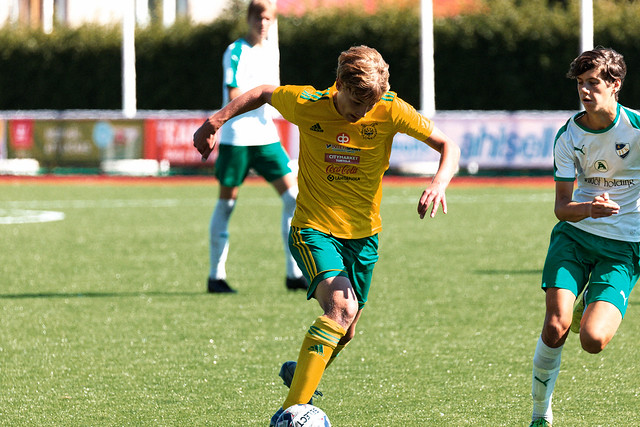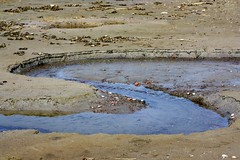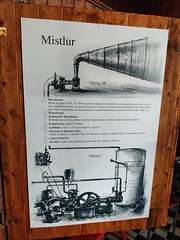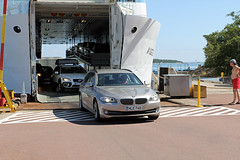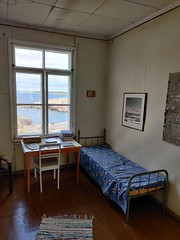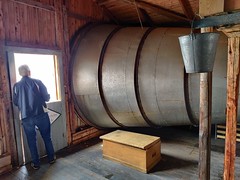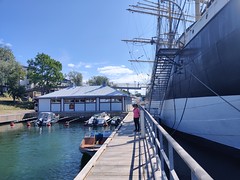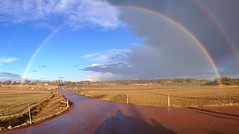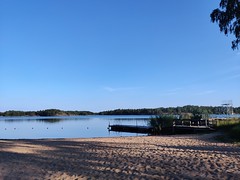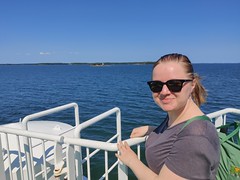 Åland
Åland
Åland (Swedish: [ˈǒːland]; Swedish: [ˈoːlɑnd]; Finnish: Ahvenanmaa: Finnish: [ˈɑhʋenɑmˌmɑː]) is an autonomous and demilitarised region of Finland since 1920 by a decision of the League of Nations. It is the smallest region of Finland by area and population, with a size of 1,580 km2, and a population of 30,129, constituting 0.51% of its land area and 0.54% of its population. Its only official language is Swedish and the capital city is Mariehamn.
Åland is situated in an archipelago, called the Åland Islands, at the entrance to the Gulf of Bothnia in the Baltic Sea belonging to Finland. It comprises Fasta Åland on which 90% of the population resides and about 6,500 skerries and islands to its east. Of Åland's thousands of islands, about 60–80 are inhabited. Fasta Åland is separated from the coast of Roslagen in Sweden by of open water to the west. In the east, the Åland archipelago is contiguous with the Finnish archipelago. Åland's only land border is located on the uninhabited skerry of Märket, which it shares with Sweden. From Mariehamn, there is a ferry distance of about to Turku, a coastal city of mainland Finland, and also to Stockholm, the capital of Sweden.
Åland's autonomous status means that those provincial powers normally exercised by representatives of the central Finnish government are largely exercised by its own government. The current demilitarised, neutral position of Åland dates back to the days of the Paris Peace Treaty after the Åland War in the 1850s. 2022 marked the 100th anniversary of the autonomous status.
Autonomy
The autonomous status of Åland was affirmed by a decision made by the League of Nations in 1921 following the Åland Islands dispute. It was reaffirmed within the treaty admitting Finland to the European Union. By law, Åland is politically neutral and entirely demilitarised, and residents are exempt from conscription to the Finnish Defence Forces. Åland was granted extensive autonomy by the Parliament of Finland in the Act on the Autonomy of Åland of 1920, which was later replaced by new legislation of the same name in 1951 and 1991. The constitution of Finland defines a "constitution of Åland" by referring to this act. Åland remains exclusively Swedish-speaking by this act. Although a referendum to join the European Union had been held in mainland Finland on 16 October 1994, Åland held a separate vote on 20 November as they were a separate customs jurisdiction. EU membership was approved by 73.64% of voters. In connection with Finland's admission to the European Union, a protocol was signed concerning Åland that stipulates, among other things, that provisions of the European Community Treaty shall not force a change of the existing restrictions for foreigners (i.e., persons who do not enjoy "home region rights"——in Åland) to acquire and hold real property or to provide certain services.
Etymology
Åland's original name was in the Proto-Norse language . Proto-Germanic is related to the Latin word for water, . In Swedish, this first developed into and eventually into , literally 'river land'—even though rivers are not a prominent feature of Åland's geography. The Finnish and Estonian names of the area, and ('perch-land', from Finnish , for the type of fish), are seen to preserve another form of the old name.
Another theory suggests that the Finnish would be the original name of the archipelago, from which the Swedish derives.
It is worth mentioning that 'avena' is Latin for 'oats'. This might have led Pliny the Elder to write of "some islands [...] the inhabitants [...] live on [...] oats" and be an indication of their name at the time of writing: AD 77.
The official name, , means 'the Region of Åland'; is cognate to English landscape.
History
Members of the Neolithic Comb Ceramic culture started settling the archipelago some 7000 years ago, after the islands had begun to re-emerge from the sea after being pushed down by the weight of the continental ice of the latest ice-age. Two Neolithic cultures met on Åland: the Comb Ceramic culture and the later Pit-Comb Ware culture which spread from the west.
Stone Age and Bronze Age people obtained food by hunting seals and birds, fishing, and gathering plants. They also started agriculture early on. From the Iron Age, Åland has six hillforts. From the Viking age there are over 380 documented burial sites.
Kastelholm Castle began constructions in the 1380s. In 1505 Kastelholm was captured by Danish navel officer Soren Norby. In 1665 and 1668 the Kastelholm witch trials took place.
The coat of arms of Åland was originally to be granted to the Swedish island province of Öland in 1560; the two had been mixed up by mistake. It displays a golden red deer (which does not live in Åland) on a blue field. This is traditionally surmounted by a comital coronet of the elder Swedish style.
Along with Finland, Åland formed part of the territory ceded to Russia by Sweden under the Treaty of Fredrikshamn in September 1809. As a result, they became part of the semi-autonomous Grand Duchy of Finland (1809–1917). During negotiations, Sweden failed to secure a provision that the islands not be fortified.
In 1832, Russia started to fortify the islands, with the great fortress of Bomarsund. In 1854, as part of the campaign in the Baltic during the Crimean War against Russia, a combined British and French force of warships and marines captured and destroyed the fortress during the Åland War. The 1856 Treaty of Paris demilitarised the entire Åland archipelago.
During the Finnish Civil War, in 1918, Swedish troops intervened as a peacekeeping force between the Russian troops stationed on the islands and "White" and "Red" Finnish troops who came from Finland over the frozen sea. Within weeks, the Swedish troops gave way to German troops who occupied Åland at the request of the "White" (conservative) Senate of Finland.
After 1917, the residents of Åland worked towards having them ceded to Sweden. In 1919 96.4% of the voters in Åland signed a petition for secession from Finland and for integration with Sweden, with over 95% in favour. Swedish nationalist sentiments had strengthened particularly as a result of the anti-Swedish tendencies in Finland and as a result of Finnish nationalism fueled by Finland's struggle to retain its autonomy and resistance against Russification. The conflict between the Swedish-speaking minority and the Finnish-speaking majority on the Finnish mainland, prominent in Finnish politics since the 1840s, contributed to the apprehension of the Åland population about a future within Finland.
Finland, however, declined to cede the islands and instead offered the islanders an autonomous status. Nevertheless, the residents did not approve the offer, and in 1921 the dispute over the islands went before the newly formed League of Nations. The latter decided that Finland should retain sovereignty over the province, but that Åland should be made an autonomous territory. One of the important proponents of a diplomatic solution to the case was Nitobe Inazō, who was one of the Under-Secretaries General of the League and the director of the International Bureaux Section, in charge of the International Committee on Intellectual Cooperation. The Åland convention of 20 October 1921, signed by Sweden, Finland, Germany, the United Kingdom, France, Italy, Denmark, Poland, Estonia, and Latvia, was the first international agreement achieved by the League. Thus, Finland was obliged to ensure the residents of Åland the right to maintain the Swedish language, as well as their own culture and local traditions. The convention of 1921 established the neutral status of Åland by international treaty, prohibiting the placing of military installations or forces on the islands. Åland's Regional Assembly convened for its first plenary session in Mariehamn on 9 June 1922; today, the day is celebrated as Self-Government Day of Åland.
Because of the condition of neutrality under the 1921 Convention, the islanders enjoyed safety at sea during World War II, as their merchant fleet sailed both for the Allied countries and for Nazi Germany. Consequently, Åland shipping was not generally attacked, as the various military forces rarely knew which cargo was being carried or to whom.
The islanders' disappointment about insufficient support from Sweden in the League of Nations, Swedish disrespect for Åland's demilitarized status in the 1930s, and some feelings of a shared destiny with Finland during and after the Second World War, changed their perception of their relationship with Finland from "a Swedish province in Finnish possession" to "an autonomous part of Finland".
Finland marked the 150th anniversary of the demilitarisation of Åland by issuing a high-value commemorative coin, the €5 150th Anniversary of Demilitarisation of Åland commemorative coin, minted in 2006. The obverse depicts a pine tree, a typical feature of Åland. The reverse features a boat's stern and rudder, with a dove perched on the tiller, a symbol of 150 years of peace.
Municipalities
Åland contains 16 municipalities. Over forty percent of all inhabitants live in Mariehamn, the capital.
- Mariehamn
- Population:
- Jomala
- Population:
- Finström
- Population:
- Lemland
- Population:
- Saltvik
- Population:
- Hammarland
- Population:
- Sund
- Population:
- Eckerö
- Population:
- Föglö
- Population:
- Geta
- Population:
- Vårdö
- Population:
- Brändö
- Population:
- Lumparland
- Population:
- Kumlinge
- Population:
- Kökar
- Population:
- Sottunga
- Population:
Population as .
Geography
Åland occupies a position of strategic importance, as it commands one of the entrances to the port of Stockholm, as well as the approaches to the Gulf of Bothnia, in addition to being situated near the Gulf of Finland.
The Åland archipelago includes nearly three hundred habitable islands, of which about 60-80 are inhabited; the remainder are merely some 6,200 skerries and desolate rocks. The archipelago is connected to Åboland archipelago in the east (Finnish: Turunmaan saaristo, Swedish…
